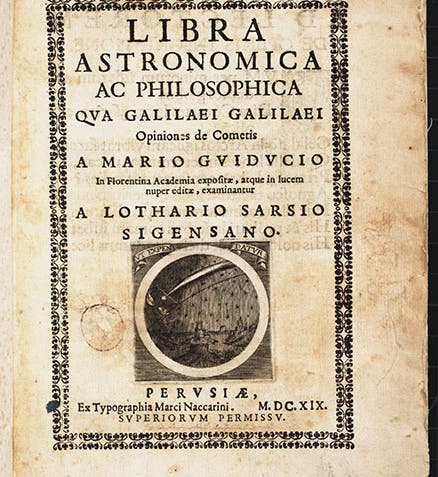Scientist of the Day - Orazio Grassi
Orazio Grassi, an Italian mathematician, Jesuit priest, and architect, was born May 1, 1583. Grassi entered the Society of Jesus when young, studied at the Collegio Romano in Rome under such notable Jesuit scientists as Christoph Clavius and Christoph Grienberger, and in 1616, found himself professor of mathematics at the Roman College. He was certainly aware of the fact that one of his fellow Jesuits, Christoph Scheiner, had independently discovered sunspots, and had been shabbily treated by Galileo Galilei in his Letters on Sunspots (1613). He also knew that Galileo had been instructed in 1616 to abandon his quest to affirm the truth of Copernicanism.
In 1618, late in the year, three comets appeared rapidly in succession, arousing widespread interest in the nature of comets, which were quite a mystery at the time. Grassi gave a lecture at the College on comets and then had his lecture printed up and published, anonymously, as Disputatio de tribus cometis (1619), in which he generally followed Tycho' Brahe's opinion that, since comets exhibit no parallax, they are far away, beyond the sun, in an orbit that circles Sun and Earth. Grassi also got a few digs in at "the Linceans," the members of the Academy of the Lynx that included Galileo and who were sponsored by Federico Cesi. Grassi also argued, without substantiation, that the movement of comets disproved the Copernican theory. We don’t own this book; you can view here the title page of the copy at the Museo Galileo in Florence.
Galileo, although sick in bed at the time, was irritated at the insinuation that the Jesuits understood comets better than he and his fellow Linceans, and that the motion of comets somehow contradicted Copernican theory. Galileo was under an injunction not to argue for the truth of Copernicanism, but he could talk about Jesuit comet theory, and in a treatise published in 1619 under the name of his pupil, Mario Guiducci, Galileo laid into Grassi's views on comets, and into Jesuit science in general. Galileo defended the thesis that comets are an optical phenomenon, caused by refraction in the upper atmosphere, which is why they exhibit no parallax. In this notion, Galileo was as mistaken as the Jesuits. Galileo also made some snide remarks about his old enemy, Scheiner, who had published his first letter on sunspots under the nom de plume, "Apelles", which is the name by which Galileo always referred to Scheiner in print, as if he did not know who his adversary really was. This 54-page treatise, with the title: Discorso delle Comete di Mario Guiducci, is not in our collection either; a copy has just now come on the market, offered by bookseller Jonathan Hill of New York, if you are interested. Here is the title page.
Grassi responded immediately with his Libra astronomica (1619), published under the pseudonym Lothario Sarsi, the title "Astronomical Balance" suggesting that the hypotheses of Galileo and the Jesuits would be weighed by argument and evidence, and that of Galileo, presumably, would be found wanting. To extend the wordplay, the engraved title-page vignette (first image) shows the last comet of 1618 appearing in the constellation of Libra, the Balance. Grassi also made repeated scurrilous attacks on Galileo in the work. We DO own this book, having purchased it in 1984 from Jonathan Hill, the dealer who is currently offering the Galileo/Guiducci treatise discussed just above. Mr. Hill would no doubt like us to complete our set, but fiscal constraints make that unlikely.
The best thing about Grassi's Libra astronomica is that it provoked Galileo to write and publish Il Saggiatore, the Assayer, in which he pulled back from the immediate and unseemly battle between Linceans and Jesuits in order to look at the larger picture: what is science, how should we practice it, how is the world to be described? Published in 1623, it is one of Galileo's most important works, and contains his oft repeated statement (slightly paraphrased here): Nature is written in that grand book, the universe, which is ever before our eyes, but we cannot understand it if who do not know the language in which it is written. That language is mathematics. The title was carefully chosen to contrast with Grassi’s title: a steelyard (libra) is a rough instrument, suitable only for crude measurements; the assayer uses a finely crafted balance, suitable for weighing gold. Galileo makes this point, mentioning Sarsi by name, right on the engraved title page (second image).
Grassi had one more book in his arsenal, published in 1626; we don't own the work, nor did Galileo respond to it. Grassi’s inadvertent role in the establishment of Galilean science was over, and Grassi went on to practice architecture, at which activity he was reasonably competent, although just as likely to raise hackles from the colleagues who had to work with him. There is no surviving portrait of Grassi, nor do we know where he was buried. Since Grassi provided the original plans for the Jesuit church of Sant’Ignazio in Rome and supervised the last stages of its construction, we will let the church be his monument.
Dr. William B. Ashworth, Jr., Consultant for the History of Science, Linda Hall Library and Associate Professor emeritus, Department of History, University of Missouri-Kansas City. Comments or corrections are welcome; please direct to ashworthw@umkc.edu.







